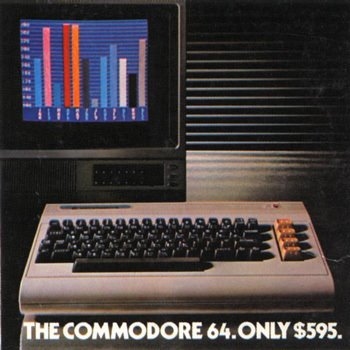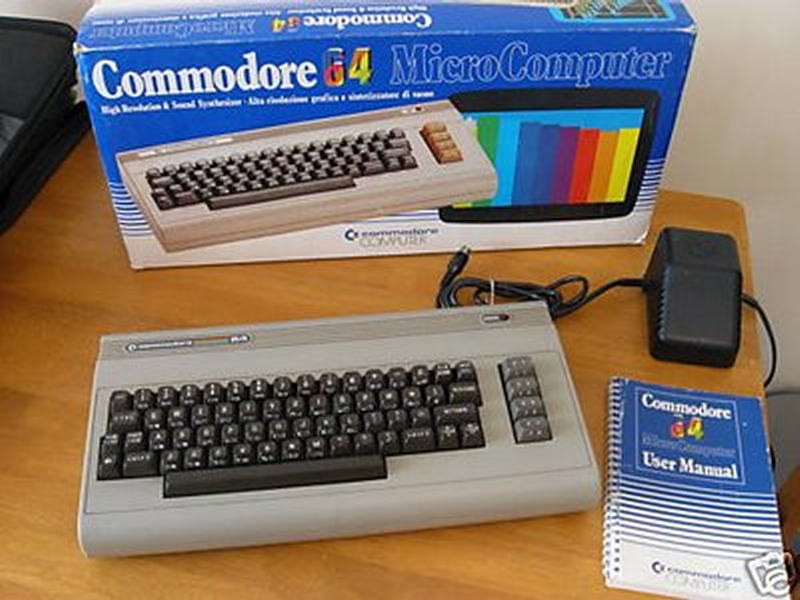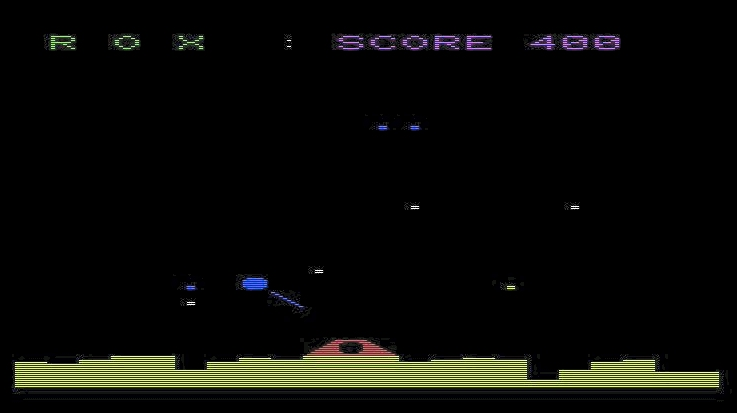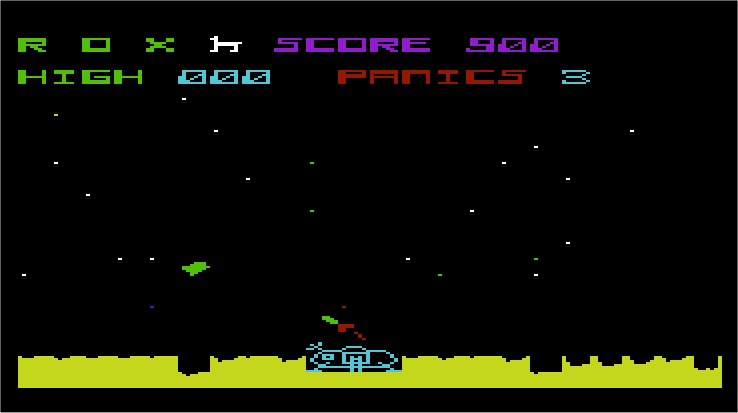
So they are saying that today is the 30th birthday of the c64. Well that’s true for certain values of “birthday” I guess. When was the C64 born? Was it back in 1981 when the designers first began work on it? Was it when it was first shown? Was it when it first went on sale?
It’d been rumoured for a while that Commodore were working on something called the VIC-40, which was to be an extension of the already quite successful VIC-20 which itself hadn’t been out in the UK all that long. And there was a weird thing in the Grattan mail order catalogues in that year which was called the Commodore Ultimax (my mum used to get those catalogues and I remember gawping at that thing and wondering what it was like. To which the answer eventually ended up being “so rubbish it was never released”. The “Vic-40″ however was a different matter…)
When it was first released in the US the first ads tried to promote the thing as a business machine. Yes – the c64 a business machine.

An error that Commodore would repeat again a few years later when they launched the Amiga – whose chipset had originally been designed to be part of a game console -as a business machine, even acting all po-faced to games developers at the time who were interested in developing for it. That’d come back to bite them on the arse quite severely when the Amiga steadfastly refused to take off compared to the less powerful but more accessible Atari ST, until they saw sense and released the Amiga 500 which was squarely aimed at gamers. But I digress.
Also look at that price. Ooyah. That’s getting on for iPad levels and that was 1982 so you’re looking at a modern equivalent of over a grand. Thank goat it didn’t remain at that price for very long.
Launch date for us UK people was still a couple of months away at this point, due out at the end of September. I was still busy building up our Vic-20 library so I wasn’t particularly trying to get one early, but in the end I did end up getting one a few weeks ahead of UK launch date. After attending our first ever computer show in June (the Commodore show at the Cunard Hotel) I’d hooked up with Jay Balakrishnan of Human Engineered Software in the US, and we’d done a deal for them to distribute some of our Llamasoft Vic-20 games, beginning with the actually rather awful Andes Attack, a Defender clone with jerky scrolling, more bugs than a Pyongyang hotel room and a ship the approximate size of a bus with handling to match).
There was another computer show due at the start of September, the Personal Computer World show at the Barbican in London. We were there pimping our latest Vic-20 games – the aforementioned Andes Attack, along with somewhat chunky and tricky to control Amidar-style game Traxx and primitive but fun unexpanded Vic bottom shooter (fnarr) Abductor – along with some fairly low-key efforts on the new Spectrum (rough ports of Rox III and Bomb Buenos Aires *cough* I mean City Bomber, and quite a nice version of Deflex, all things that were easy to write in Sinclair BASIC) and the Atari 8-bits (yet another version of Deflex; the lovely A8 version of AMC was still a few months away at that point). We probably even had a ZX81 there running Centipede, bless it.
I do recall those Barbican shows being incredibly crowded and noisy, loads of small game companies there and everyone cranking up their sound effects to be heard above the general cacophany. Our own game Traxx certainly didn’t help, being as it played the theme from Amidar constantly, loudly and gratingly off key. Continuously. Loudly. All day. You could barely move in there and it was hot and full of nerdstink, ahh, those were the days. So it was something of a relief when Jay Balakrishnan came by – he was over on a trip looking for more software to sell in the US – and he told me he’d got a present for me back at his hotel room (that sounds dodgy but it totally wasn’t!). It was good to have a couple of hours out of the show walking to his hotel where he presented me with a shiny new c64, still a few weeks before the official UK street date. Score!
It also presented us with a bit of hassle too though. It was a US machine so it needed 110V instead of 240 proper British volts, and it used the American “NTSC” (which stood for Never Twice Same Colour, an inferior foreign TV standard) system. Proper British tellies wouldn’t like that at all, so in order to be able to use it we needed a bit of extra kit (which probably ended up working out being more expensive than simply waiting a few weeks and buying a UK C64, but it gave us a little headstart I suppose and it was genuinely useful kit to have around in the years to come). Accordingly me and my dad headed off on the tube to Tottenham Court Road and bought a stepdown transformer to give us the necessary 110V (I think we still have that somewhere and it still works) and a JVC multi-standard video monitor that could handle two different flavours of NTSC as well as PAL (the Queen’s own video standard) and SECAM (only used by the French). I remember that monitor being a big old thing to be horsing about on the tube.
It was still an excellent score though since I think the only other people we saw at that show with an honest to god C64 were Rabbit Software (I believe they were importing games by “Nufekop”, whose early efforts were just about as hilariously primitive as my own).
(Speaking of the tube, the first day of that Barbican show – 9 September – was the release date for the film “Blade Runner” in UK cinemas. Consequently the tube was full of posters adveritsing the film, and it was one of those posters which game me the idea of a theme for my as-yet-unwritten new Vic-20 Centipede-style game).
Eventually we all got back home after the show and the US c64, along with the necessary gubbins to use it, was installed in my bedroom.

(Not my actual c64 in this pic. Or my bedroom)
Actual info about the new machine was still pretty thin on the ground at that time, at least in the UK, and that thin little manual was all I had to go on (and most of *that* was about teaching beginners BASIC which was of no interest to me). At least it told you where the addresses were in memory for the special chips that controlled the sprites and sound effects which were the main attractions of the new machine. I didn’t even have any kind of machine code monitor at that point so I thought as a learning exercise I’d convert one of my very first Vic-20 games, something I knew would work in just BASIC and a bit of poking and which I could hopefully use the new machine’s capabilities to tart up a bit whilst learning my way round the new stuff as I went along.
So my first ever c64 game was rather obscure and not terribly amazing but it was all done in one evening the first night I got the machine set up.
On the old Vic 20 I’d written a little game called ROX that me and my dad enjoyed playing quite a lot one Christmas.

It was a really simple game, a bit like Astrosmash on the Intellivision come to think of it, except simpler in that you didn’t move your little base at all, you could just fire up rockets to intercept falling rocks. If too many rocks hit the ground it’d make a hole and that’s be game over.
I’d added a few little things to that game and tarted it up with some UDGs and the obligatory awkward to read character set and turned it into “Rox III”:

although I’m not sure if we ever even sold it on the Vic ourselves since we really didn’t like that much selling programs written in ropey old BASIC.
However since at that time there was basically nothing at all out on the c64 I thought it might be an idea to release Rox on the 64 as a BASIC program that other users could LIST to see how the new chips worked themselves, so we did end up selling it for a while on the 64, just at a low price so that people wouldn’t think we were trying to take the piss.

It just BARELY made use of the new machine’s features, using a single sprite for the lunar module (and a right pain in the arse it was drawing that thing on graph paper and converting it into BASIC DATA statements to be poked into sprite RAM; unsurprisingly enough one of the very next things I wrote was a proper sprite editor) which would land on the lunar surface (lovingly constructed out of ropey old PET graphic blocks) to the accompaniment of various whooshing noises from the SID chip.

So my first C64 program was a pretty low-key and unassuming thing, but it was a first step on what was to be a long and enjoyable road. After I finished writing that sprite editor I began straight away using it to draw some big and crudely drawn camels, which looked more like two fat men in a camel suit…

(Nothing at all to do with the C64, just a drawing from a C&VG from around that time which I was looking through in search of old Llamasoft ads from that era. It was the only illustration in an article about PRESTEL, believe it or not. Gotta love early 80s era C&VG art style!).











